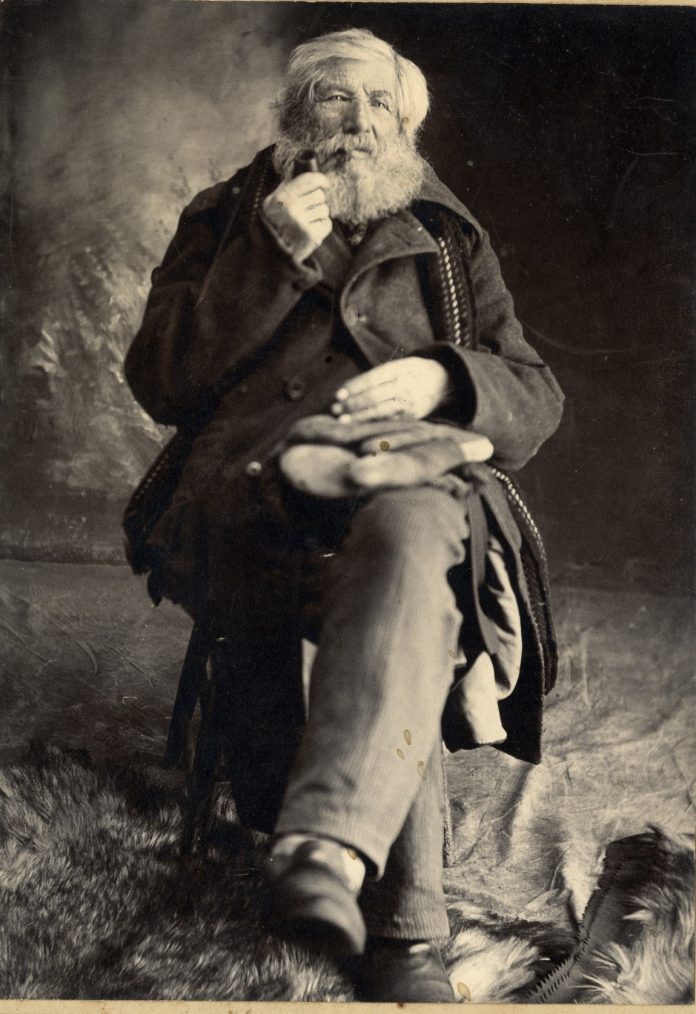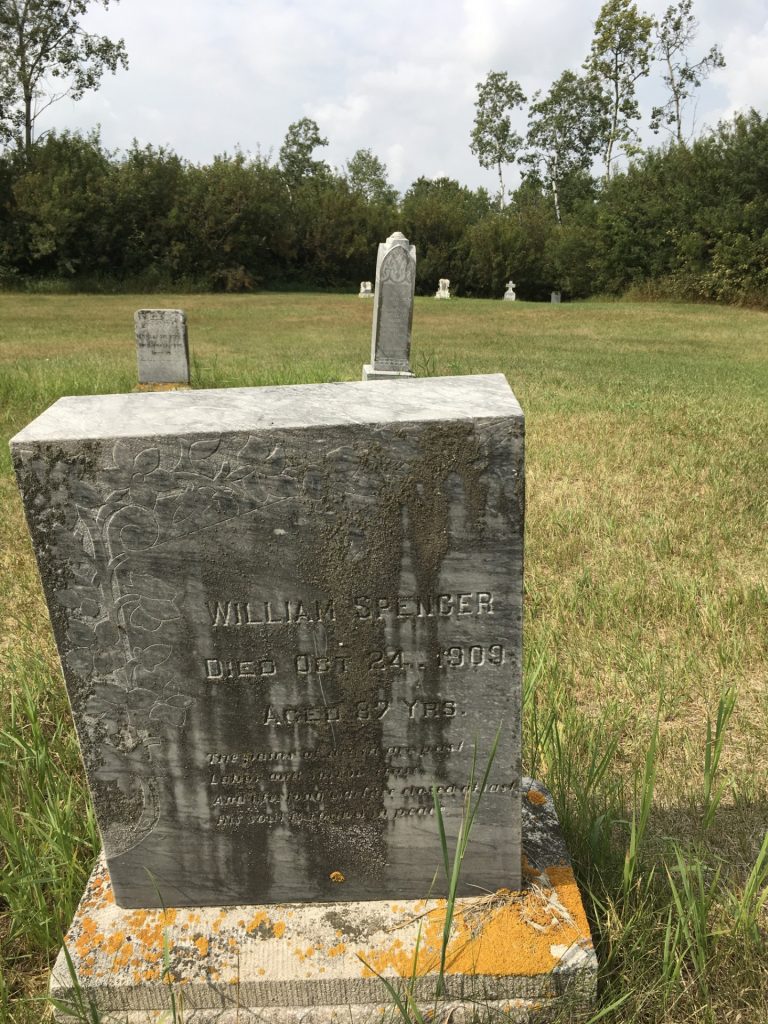
Fred Payton
Prince Albert Historical Society
A few weeks ago, we drove east on Highway 302 towards the Stanleyville district. It was a beautiful morning, making for a pleasant outing in search of the district’s cemetery, where I believed the remains of William A. Spencer had been interred in 1909.
The cemetery had once been the site of Holy Trinity church, but the church had been moved off-site in 1968. We were not certain what to expect with respect to the cemetery. Would it be neglected and overgrown, as is often the case for so many early cemeteries in rural areas? Would it be possible to locate and read the headstones, many of which had been erected over one hundred years ago?

The grave of William A. Spencer in the cemetery of the former Holy Trinity Church.
We finally located the cemetery, thanks to the assistance of an area farm family, and were pleased to see that the cemetery was well maintained. A cairn identified the origin of the graveyard, and most of the headstones were easily read. Many of the names were connected to the earliest settlers in the Prince Albert district, including families such as the Markleys, Robertsons, Andersons, and McBeaths. Easily found, and easily read, were headstones erected in memory of members of the Spencer family including, of course, Willam A. Spencer.
You may be wondering: why the interest in William Spencer? Some of you may recall Ernie Spencer, onetime Prince Albert’s deputy fire chief. He was a descendant of William Spencer. There are several other descendants of the man still residing in Prince Albert, and these connections which make it of interest to persons who are fascinated by genealogy and family trees. But even without these connections, I found the life of William Spencer to be a life of interest and significance.
The first point of interest relates to the place of Spencer’s birth. According to an article written by Joan Frith in 1988, Spencer was born in 1822 in the Orkney Islands, and apprenticed to the Hudson Bay Company in 1838 at the age of 16. He is said to have arrived in York Factory in June of that year, on the annual supply ship from England. Other documentation suggests that Spencer was born on James Bay at Moose Factory, Keewatin District North-West Territories to John Hodges Spencer and Anne Sinclair.
Regardless of his place of birth, Spencer was hired on as an apprentice at York Factory. In this role, he was expected to serve as an understudy and assistant to men of higher ranks.
After his first two years at York Factory, he served a further two years in the Sandwich Islands (Hawaii), before being moved to Fort Vancouver. According to Frith, the cold weather, isolation and the Company’s harsh rules discouraged many of the young apprentices and drove them to suicide. However, she states, Spencer having been raised in the bleak Orkney Islands, was prepared for the climactic and other hardships. Apprenticing in the Sandwich Islands and on coastal British Columbia might not have been too great a challenge to an Orkney Islander.
The salary for apprentices was lower than for labourers, but the prospects of promotion were greater. Most apprentices spent their time doing menial tasks and running errands. Spencer had a quick mind, and could read and write and do arithmetic, allowing him to engage in tasks with his superiors which led to a deeper understanding of the Company’s workings, as well as its failings.
When his term as an apprentice expired, Spencer was offered a position as a clerk. Spencer argued that in order to be a good clerk he must experience life outside of the fort in order to understand how to correct some of the Company’s faults. As a result, he secured a position on the English River (now known as the Churchill) as a “middleman” which, contrary to its title, was one of the lower ranks. However, it afforded Spencer the opportunity to canoe and portage across the Company’s territory and gain access to its trading posts, as well as to interact with the First Nations people.
Spencer also had a knack for languages and quickly learned the Indigenous tongues. This led to his appointment in 1846 as an interpreter, a position considered to be very valuable in the fur trade industry. Regardless of their value, interpreters were not allowed to keep company with the Chief Factors or to eat in the Company dining halls.
Spencer served as an interpreter for three years in the Lesser Slave Lake region and the Rocky Mountain House region. Often at the centre of controversy, he made gains in improving the interaction between the fur traders and the First Nations people, and was known to report those traders who were not dealing fairly with the Indigenous people.
In 1849, Spencer accepted a position as the post master at Fort Carlton. This post had little to do with handling mail, but was more an internal trouble shooter, mediating between the First Nations people, the traders, the local residents, the Company servants and its officer. He was later appointed clerk at several of the Company’s stations, during which time the Company finally realised its internal failings, failings which had earlier been noted by Spencer while serving as an interpreter.
In 1848 and 1849, while at Rocky Mountain House, Spencer had become acquainted with Patrick Small, another interpreter. He was introduced to Small’s family and, on July 15, 1848, he married Small’s daughter Caroline. They eventually had ten children, six boys and four girls. Three of the boys were educated at St. John’s College in Winnipeg, and subsequently apprenticed to the Hudson’s Bay Company.
After serving at Carlton, Spencer served at The Pas, and Cumberland House (the latter place in the summer months), Berens River (on Lake Winnipeg), Stanley Mission, Cold Lake, and in communities on or near the English River (La Loche, Ile-a-la-Crosse).
Spencer retired in 1856, partly due to his wife’s failing health, but also due to rumours that the Company was giving up its monopoly. They settled in Prince Albert, where Spencer was appointed the registrar of new born babies. He was active in the community, serving on the Goschen school board. He was also approached to act as a mediator in the dispute between the Metis and the federal government. Although he recognised the Metis grievances, he soon found that Louis Riel was not prepared to participate in the mediation process and accordingly resigned from the position.
Spencer’s wife, Caroline, died in 1886, and he left Prince Albert to take up a homestead in the Stanleyville district east of Prince Albert. As the eldest person to acquire a homestead in that community, he required the assistance of his son and family to build a log house and to work the land in order to meet the homestead requirements. Spencer continued at this time to act as the registrar of babies and made many trips on foot to Prince Albert. (Did I previously mention that Stanleyville is about 25 kilometres or 15 miles from Prince Albert?) He preferred to walk and, according to his daughter Elsie, refused to utilise any other form of transportation.
Spencer died in 1909 at the age of 87.

